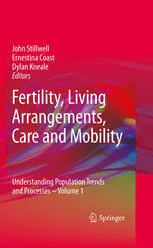
Fertility, Living Arrangements, Care and Mobility: Understanding Population Trends and Processes - Volume 1 PDF
Preview Fertility, Living Arrangements, Care and Mobility: Understanding Population Trends and Processes - Volume 1
Fertility, Living Arrangements, Care and Mobility Understanding Population Trends and Processes Volume 1 SeriesEditor J.Stillwell In western Europe and other developed parts of the world, there are some very significantdemographicprocessestaking place at the individual,household,com- munity and national scales including the ageing of the population, the delay in childbearing,the rise in childlessness, the increase in divorce,the fall in marriage rates, the increase in cohabitation,the increase in mixed marriages, the change in householdstructures,theriseinstep-parenting,andtheappearanceofnewstreams of migration taking place both within and between countries. The relationships betweendemographicchange,internationalmigration,labourand housing market dynamics,careprovisionandintergenerationalattitudesarecomplextounderstand andyetitisvitaltoquantifythetrendsandtounderstandtheprocesses.Similarly,it iscriticaltoappreciatewhatthepolicyconsequencesareforthetrendsandprocesses thathavebecomeapparent.Thisserieshasitsrootsinunderstandingandanalyzing thesetrendsandprocesses. Thisserieswillbeofinteresttoawiderangeofindividualswithinterestsindemo- graphicandsocialchange,includingdemographers,populationgeographers,soci- ologists,economists,politicalscientists,epidemiologistsandhealthresearchersand wellaspractitionersandcommentatorsacrossthesocialsciences. Forfurthervolumes: http://www.springer.com/series/8113 Fertility, Living Arrangements, Care and Mobility Understanding Population Trends and Processes - Volume 1 Editedby JohnStillwell UniversityofLeeds,UK ErnestinaCoast LondonSchoolofEconomics,UK and DylanKneale InstituteofEducation,UniversityofLondon,UK 123 Editors ProfessorJohnStillwell Dr.ErnestinaCoast UniversityofLeeds LondonSchoolofEconomics SchoolofGeography Dept.SocialPolicy Fac.EarthandEnvironment HougtonSt. WoodhouseLane London Leeds UnitedKingdomWC2A2AE UnitedKingdomLS29JT [email protected] [email protected] DylanKneale UniversityofLondon Inst.Education 20BedfordWay London UnitedKingdomWC1H0AL [email protected] ISSN 8113 ISBN 978-1-4020-9681-5 e-ISBN 978-1-4020-9682-2 DOI10.1007/978-1-4020-9682-2 SpringerDordrechtHeidelbergLondonNewYork LibraryofCongressControlNumber:2008942396 (cid:2)c SpringerScience+BusinessMediaB.V.2009 Nopartofthisworkmaybereproduced,storedinaretrievalsystem,ortransmittedinanyformorby anymeans,electronic,mechanical,photocopying,microfilming,recordingorotherwise,withoutwritten permissionfromthePublisher,withtheexceptionofanymaterialsuppliedspecificallyforthepurpose ofbeingenteredandexecutedonacomputersystem,forexclusiveusebythepurchaserofthework. Printedonacid-freepaper SpringerispartofSpringerScience+BusinessMedia(www.springer.com) Foreword One of the great undertapped sources of social science research has been the plethora of data from wonderful surveys and censuses, available for secondary analysis through the Economic and Social Data Service or elsewhere, which do notreceivetherichandthoroughanalysistheydeserve. The Economic and Social Research Council (ESRC) has attempted to address this in two ways: througha sustained programmeof methodsdevelopmentled by theNationalCentreforResearchMethodsandbydevelopingthecapacityofsocial scientiststoundertakethesecondaryanalysisoflargedatasets.Thisbookcontainsa seriesofessaysfromsomeoftheresearchersontheverysuccessful‘Understanding PopulationTrendsandProcesses’(UPTAP)scheme. These essays are on linked themes of fertility, living arrangements, care and mobilitywhicharecentraltooneofESRC’skeypriorities.AsUKsocietybecomes ever more diverse, understanding the seismic changes occurring in the UK pop- ulation has become increasingly more important and the need to develop policy responseshasbecomemoreurgent.Thisexcellentbookprovidessomeexcitingand thoughtfulinsightsintosomeimportantareasofbothresearchandpolicyformation. FinallyIwouldliketothankJohnStillwell,whohasdirectedtheprogrammewith alacrity and drivefor all his work, notonly in the programmebut, with Ernestina Coastand DylanKneale, on the productionof this excellentvolume,the first ofa seriesonUnderstandingPopulationTrendsandProcesses. Swindon IanDiamond September2008 v Preface The world is changing rapidly and population dynamics are a hugely important dimension of global transformation. Demographic restructuring is one of the big challengesofthetwenty-firstcentury.Notonlydothecomponentsandcomplexion ofpopulationchangeprovideafascinatingarenafortheresearchcommunity,they presentquestionsofcriticalimportanceforpractitionersandpolicymakers. Thisbookisthefirst ina serieson‘UnderstandingPopulationTrendsandPro- cesses’,allofwhicharebasedonresearchcontributionstoourknowledgeofdiffer- entaspectsofpopulationstructureanddistribution,allofwhichinvolvetheanalysis ofsecondarydatafromcensuses,surveysoradministrativerecords,andallofwhich reportresultsforBritain(andelsewhereinEuropeinsomecases). This volume brings together a series of studies that focus particularly on the householdandtherolesofadultsandchildren.Particularattentionispaidtostudies of bearing and raising children, of living together or alone, of caring for those in need, and of moving home or changing school – hence the four cross-cutting themesthatconstitutethesubtitleofthebook–fertility,livingarrangements,care andmobility. Leeds,UK JohnStillwell London,UK ErnestinaCoast London,UK DylanKneale September2008 vii Acknowledgements AlltheresearchreportedinthisvolumehasbeenfundedbytheUKEconomicand SocialResearch Council(ESRC) aspartof the ‘UnderstandingPopulationTrends and Processes’ (UPTAP) programme. John Stillwell, the programme director, is gratefulforthesupporthehasreceivedfromstaffattheESRC,particularlyJeremy Neathy,MikeBright,JoDuffy,JenniferEdwardsandHeathBampton. The editors would like to thank the contributors for providing draft chapters on time and respondingto editorialcomments so promptly.Thanks also to David Appleyard in the Graphics Unit at the School of Geography,University of Leeds whohasdoneagreatjobinredrawingallthefiguresinaconsistentstyle. ix Contents 1 Fertility,LivingArrangements,CareandMobility ................. 1 DylanKneale, ErnestinaCoastandJohnStillwell 2 DelayedChildbearingandChildlessness .......................... 23 RoonaSimpson 3 Women’sEducationandChildbearing:AGrowingDivide .......... 41 SarahSmithandAnitaRatcliffe 4 The Timing of Motherhood, Mothers’ Employment and Child Outcomes...................................................... 59 KirstineHansen, DeniseHawkesandHeatherJoshi 5 EarlyParenthood:DefinitionandPredictioninTwoBritishCohorts . 81 DylanKneale 6 CurrentlyCohabiting:RelationshipAttitudes,Expectationsand Outcomes......................................................105 ErnestinaCoast 7 LivingArrangements,HealthandWell-Being......................127 HarrietYoungand EmilyGrundy 8 StepparentingandMentalHealth ................................151 Peteke Feijten, Paul Boyle, Zhiqiang Feng, Vernon Gayle and ElspethGraham 9 GrandparentsandtheCareofTheirGrandchildren................171 AlisonSmithKoslowski xi xii Contents 10 InternalMigrationandInter-householdRelationships..............191 OliverDuke-Williams 11 ExploringDimensionsofSchoolChangeDuringPrimaryEducation inEngland.....................................................211 JoanWilson Index .............................................................239
